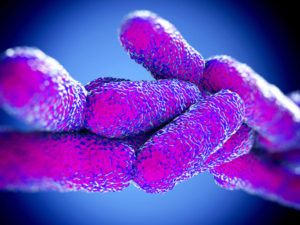By Jan Worth-Nelson

Flint’s latest nemesis: shigella bacteria
Incidence of the latest health threat to hit Flint and Genesee County, the diarrhea-causing bacterium shigella, appears to have subsided, at least for now, representatives from the Centers for Disease Control told the Flint Water Recovery Group under the dome at City Hall last week.
Jevon D. McFadden, a CDC physician headquartered in Lansing, told the group that as of Oct. 19 no new cases of shigellosis, the disease caused by the bacterium, had been reported in Genesee County for several weeks.
And he said no new cases have been reported for two weeks in Saginaw County, a parallel recent shigella hot spot.
But CDC experts and state and county health authorities continue to investigate the outbreak, which emerged in March and spiked in both Genesee and Saginaw counties over the summer.
A total of 135 cases have been reported since March — 85 in Genesee County and 50 in Saginaw County, McFadden said. The largest number of cases in both counties occurred in June. No one has died, though a number of patients have been hospitalized – mostly from dehydration.

Jevon McFadden at the FWRG
The actual number of cases likely was higher than documented, McFadden said, due to some people possibly not recognizing or reporting symptoms, which can include bloody diarrhea and stomach pain. For most people the disease lasts several days to a week, and in healthy people it usually clears up on its own. But for some, effects can last for months.
In the midst of the outbreak, McFadden said, state and county health authorities requested help in tracking possible causes of the shigella spike, which many local residents worried was another outgrowth of the water crisis.
Michael Beach, CDC associate director for healthy water from the Atlanta CDC office and a nationally-known expert in waterborne infectious diseases, came to Flint in early October, meeting with local health providers and community leaders to help guide the investigation.
So far, no scientific link to the water crisis has materialized, the researchers stated, but neither has it been ruled out. “We are committed to following the science wherever it takes us,” Beach stressed.
Several factors suggest – but do not prove — that it may not be the direct result of the water crisis. First, many of the cases occurred outcounty, outside of the Flint water service area.
Second, the occurrence of the Saginaw cases makes researchers wonder how the bacteria would have emerged and spread if it came from Flint. And as McFadden pointed out, the trends of when people were ill were nearly identical in both counties.

Michael Beach addressing the FWRG
Beach further noted that chlorine effectively kills shigella, and as local residents following the water crisis know, monitoring and sustaining the chlorine levels of treated water in Flint has been central to recovery efforts this year.
Mark Durno, a supervisory engineer from the Environmental Protection Agency and a familiar figure in local water crisis efforts and discussions, was at the recovery group meeting for the shigella discussion. He confirmed chlorine added to Flint water was within required levels all summer.
The CDC researchers noted that the best preventive for spread of the virus is hand washing with soap and water. The bacteria spread person-to-person through contact with feces, contaminated food or untreated water such as in ponds or lakes.
Since it causes diarrhea, it can be especially hard to eliminate for those caring for small children or the elderly with the disease.
Beach urged residents to take special care to wash their hands after changing diapers and before food preparation.
Local residents at the meeting voiced concerns that while the water crisis might not have directly caused the outbreak, residents’ fear of water might have added to the summer spike.
Ironically, some residents at the meeting observed, hand washing in the much-maligned Flint water this summer might have been a better alternative than bottled water, at least for preventing shigellosis, since the treated Flint water contains chlorine.
Nationally, about 7-8.000 cases of shigellosis are reported annually. The number occurring in Flint and Saginaw represented “a significant increase” for the area, Beach said, which had run about 40 cases per year previously in the affected areas.
Beach stressed that the CDC and local health authorities “don’t have all the answers,” but noted the effort to track down and prevent further incidences continues.
“You folks have gone through a lot,” Beach commented to the water recovery group. “I feel the fatigue. It is a testament to all of you that you’ve kept going.”
In the parking lot after the meeting, one resident shook her head about the latest Flint health scare and commented, “Well, after all we’ve been through, this doesn’t seem so bad.”
A CDC team including McFadden and Jonathan Yoder, a waterborne disease and outbreak surveillance system coordinator, are designing a questionnaire for further investigations and interviews with residents to explore causes and sources of the outbreak.
EVM Editor Jan Worth-Nelson can be reached at janworth1118@gmail.com.



You must be logged in to post a comment.